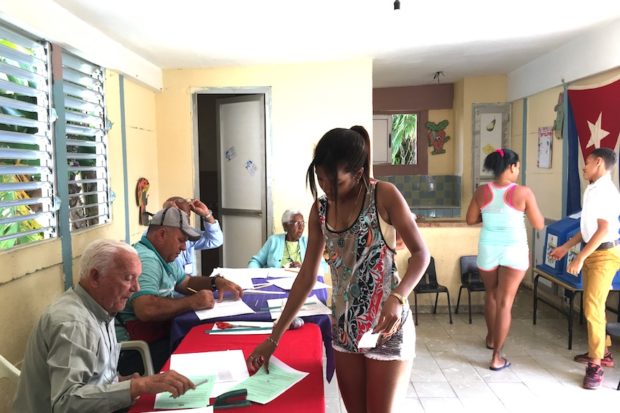
By Leni Villagomez Reeves
Cuba has a parliamentary system of government: Cuba has worked out a system, no doubt imperfect like all systems, that sets up nominations for delegates to the municipal assemblies on a small neighborhood and group basis, with two or three candidates on the ballot for each position. There is no political campaigning and no money raised or spent. Those voters who don’t have personal knowledge of the candidates check out their biographical info, which is posted all over in places such as bakeries and pharmacies. People tend to elect delegates who they think will be capable and work hard for the district, and be accountable, accessible and good at explaining things.
The National Assembly is largely elected from these municipal assemblies. Any citizen, without having, raising or spending the huge sums that U.S. political campaigns cost, can be elected as a delegate.
The elections are always held on Sunday to make it easy for people to vote, and the polling places are numerous and close to home, open all day. The longest line I have personally seen to vote in Cuba, where participation in the first phase of the election was above 88 percent, was about five minutes, and I am not located in a fancy area.
I was present in Cuba for both the first and second phases of the elections. There is a secret ballot and a transparent counting process open to all who wish to observe at the neighborhood level.
I do realize that you have been told all your life that Cuba is a dictatorship and this business of elections may come as news. What? Your government has been lying to you all this time? Is this a surprise?
Elections
Phase one of the electoral process took place on Nov. 26, 2017. The delegados de base— delegates to the 168 municipal assemblies—were elected in contested elections with several candidates for each position. (You can read an account in the January 2018 edition of the Community Alliance.)
The next phase occurred on March 11 with the election of delegates to the provincial assemblies and deputies to the national assembly or parliament. At least half must be chosen from among those directly elected in the November local assembly elections. Others are selected to be candidates by their schools, workplaces, unions and other organizations. The March election is a ratification of these choices; they must receive at least 50 percent yes votes to be elected. The second phase of the election saw 82 percent Cubans voting. Voting is usual but not obligatory.
Diversity
Of the 605 candidates for the National Assembly, 47.4 percent are women, which will give a representation of 53 percent women in parliament and 40.6 percent are black or mixed race.
Cuba’s New President
On April 19, the 605 Diputados (delegates) who were elected in March to the Asamblea Nacional del Poder Popular (National Assembly of People’s Power, or the national parliament) of Cuba met to choose a new government —the Consejo del Estado (Council of the State)—which is the president, the first vice president, five other vice presidents, the secretary and 23 members of the Consejo. This is the first time in post-revolutionary Cuba that the country will have a top leader who is neither Fidel nor Raul.
Diaz-Canel?
Most people think the most likely person to assume the presidency will be Miguel Diaz- Canel Bermudez, a 58-year-old electrical engineer/professor from Villa Clara who has been first vice president for the past five years and previously was minister of higher education.
“Cuba Post-Castro”
After Fidel’s death in November of 2016, the slogan Yo Soy Fidel (I am Fidel) began to be widely used in Cuba. The idea is that the revolutionary ideals and process have become part of the people of Cuba and that the physical absence of Fidel leaves a spiritual presence, carrying on the struggle for liberation. What are those ideals? This is the way Fidel expounded them on May Day in 2001:
What is revolution?—Fidel Castro Ruz
“Revolution is the sense of the historic moment;
it is changing everything that should be changed;
it is full equality and freedom;
it is being treated and treating others as human beings;
it is liberating ourselves by our own efforts;
it is defying powerful dominant forces within and outside of the social and national sphere;
it is defending the values that we believe in at the price of any sacrifice;
it is modesty, unselfishness, altruism, solidarity and heroism;
it is fighting with boldness, intelligence and realism;
it is never lying or violating ethical principles;
it is the profound conviction that there is no force in the world capable of crushing the force of truth and ideas.
Revolution is unity, it is independence,
it is fighting for our dreams of justice for Cuba and the world,
it is the base of our patriotism, our socialism and our internationalism”
Want a look at the real Cuba?
There still might be a few places open on the Pastors for Peace Caravan to Cuba, July 16–29, although the deadline for applications was May 1. Application forms are available from friendshipmentcaravan@ifconews.org or by calling 212- 926-5757 ext. 6.
*****
Leni Villagomez Reeves is a local solidarity, peace and social justice activist who goes to Cuba about three times a year, with the Pastors for Peace Caravan and on her own, and has strong personal ties on the island. Contact her at lenivreeves@gmail.com.
